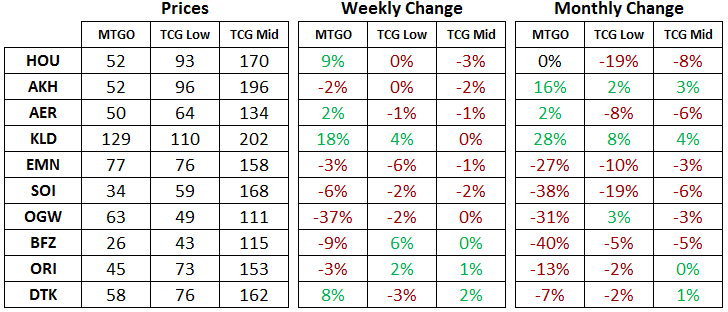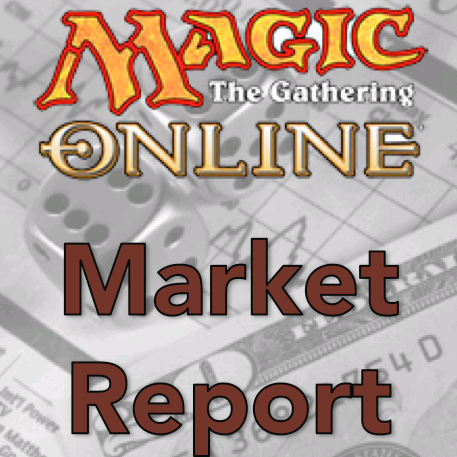Are you a Quiet Speculation member?
If not, now is a perfect time to join up! Our powerful tools, breaking-news analysis, and exclusive Discord channel will make sure you stay up to date and ahead of the curve.
Welcome to the MTGO Market Report as compiled by Matthew Lewis. The report will cover a range of topics, including a summary of set prices and price changes for redeemable sets, a look at the major trends in various Constructed formats and a "Trade of the Week" section that highlights a particular speculative strategy with an example and accompanying explanation.
As always, speculators should take into account their own budgets, risk tolerances and current portfolios before buying or selling any digital objects. Please send questions via private message or post below in the article comments.
Redemption
Below are the total set prices for all redeemable sets on MTGO. All prices are current as of August 21, 2017. The TCGplayer low and TCGplayer mid prices are the sum of each set's individual card prices on TCGplayer, either the low price or the mid price respectively.
All MTGO set prices this week are taken from GoatBot's website, and all weekly changes are now calculated relative to GoatBot's "full set" prices from the previous week. All monthly changes are also relative to the previous month's prices, taken from GoatBot's website at that time. Occasionally, full set prices are not available, and so estimated set prices are used instead. Although both Aether Revolt (AER) and Kaladesh (KLD) are no longer available for redemption, their prices will continue to be tracked while they are in Standard.

Standard
The other shoe dropped this week as Oath of the Gatewatch (OGW) put up a massive red number, down 37 percent. Although this set has powerful Eldrazi creatures that are staples in Modern, the reality is that there were many cards priced at a high level due to their Standard play. Nissa, Voice of Zendikar was 15 tix but is now down to 7 tix, and Kozilek's Return went from 17 tix down to 6 tix. There will be a buying opportunity on cards from OGW, but at the moment, there's room for further declines.
In general, it's a little early to be bottom fishing on cards rotating out of Standard, but Archangel Avacyn at 1.2 tix is very tempting. This card has had a rough go of it in Standard since she ruled the skies in the U/W flash archetype and was priced at 20 tix. That deck never completely recovered from the banning of Reflector Mage, and the Standard metagame moved on. I wouldn't be afraid to start nibbling on this card in the 1.0 tix to 1.2 tix range, but if the price drops into the 0.5 to 0.6 tix range, then I would buy multiple play sets.
Avacyn ticks many boxes in terms of having value. It's a large-set mythic rare, so redeemers will eventually want some of these to complete their Shadows over Innistrad (SOI) sets. It's an Angel, so there is some casual appeal, and there's an outside shot at showing up in Modern. Taken all together, Avacyn is looking good from a speculative standpoint, we just need to see signs of a price bottom.
Another white mythic rare that has piqued my interest this week is the flagship card from Battle for Zendikar (BFZ), namely Gideon, Ally of Zendikar. It's got many similar attributes to Avacyn, but Gideon actually gets played in multiple archetypes in Modern. Again, it's a little early to be bottom fishing, but Gideon at 5 tix is a very tempting price.
For a card that is not rotating out of Standard, Abrade looks like a staple uncommon and it will stick around as long as the artifact themed sets of KLD block do. The best prior example of speculating on small-set uncommons is Fatal Push, which dipped below 2 tix back when AER was still being drafted. Although Abrade is not on the same level as a Modern staple like Fatal Push, it's also found a price range just above 1.0 tix which is commensurate to its use in Standard. We are in the final phases of Amonkhet (AKH) block draft which means that the supply of this card is very nearly at its peak. As long as Abrade continues to see play, I would look for it to reach a price of 2 tix at some point during the fall and winter as the Standard metagame evolves.
Modern
Flashback drafts return this week with triple Ravnica: City of Guilds (RAV). This is an unbalanced draft format as the original Ravnica block featured the innovative guild structure, with four of the ten guilds being featured in the first set. The value is not great on these boosters, so be sure to brush up on draft strategies before entering the queues, as you are unlikely to get bailed out with a pricey rare. Players should target the Modern playables from this set on the weekend, with cards like Dark Confidant, Life from the Loam and Birds of Paradise among others.
There was a Modern Challenge on MTGO this past weekend and the top decks are here. TitanShift piloted by long time MTGO grinder _Batutinha_ took the top spot, with the deck featuring three copies of Hour of Promise. Scapeshift has made a push to 40 tix, but it's a little stretched at this point and has fallen back to 36 tix. Look for it to stabilize in the low 30s over the coming weeks. A dip back down to 25 tix or lower after Ixalan (XLN) is released would be a good buying opportunity.
Standard Boosters
A draft set of KLD block hit 9.5 tix this week, which is not far off the price of the most current draft format of AKH block. At this point, I've completely sold down my stock of KLD and AER boosters. This means I didn't catch the peak, but I am still happy with the way this speculative strategy played out
I bought one hundred draft sets for the portfolio back in the spring. It turned out that KLD boosters have been the more profitable booster on a percentage basis, returning 43 percent, or 54 tix on 125 tix invested, while AER returned 21 percent, or 117 tix on 560 tix invested.
Based on my experience with KLD and AER, I don't think it's correct focus on one booster over the other. I think there's an advantage in buying them in draft set ratios as you get to buy more boosters in one go and you get to manage your risk by adding both into your portfolio. Finally, when it comes time to sell them it's difficult to sell a bunch of boosters at once as most competitively priced bot chains will usually only take a draft set or two of non current draft formats. Thus it took a lot of transactions to get through my stock of boosters, but as a safe and grindy spec, it ended up being worthwhile.
As we go forward, this strategy will be applicable to AKH and Hour of Devastation (HOU) boosters at the end of September. When XLN is released, I'll be targeting AKH block draft sets at a price of 7 tix or less. The price target for exiting the trade will be 9 tix by February or March of 2018.
Trade of the Week
For a complete look at my recent trades, please check out the portfolio. Two weeks ago I bought into Chameleon Colossus as it rode a steady uptrend on account of being included in Modern sideboards to fight Grixis Death's Shadow decks. That deck has adapted by upping its Liliana of the Veil count, so the effectiveness of Chameleon Colossus as a sideboard answer is diminished.
With this in mind, I found the market to be well supplied in the 20- to 21-tix range, so it was prudent to exit this trade. Once supply catches up to the current price, then the trend is at risk of ending. In this case, the supply was signalling to me that the trend was over, and this lined up neatly with the metagame chatter related to this card. As a result, I liquidated my copies at current prices and the trade returned 27 percent, or 98 tix on 460 tix invested.
The original thesis was to hold this position for four to six weeks, but that was contingent on the trend continuing. Although it's possible I have not read the market correctly, I feel the trend is over and that exiting the position was the correct move. Getting liquid over the next month is a big priority for me as I prepare for the release of XLN and fall rotation.






Nice play on the Chameleon Colossus. Ive gotten burned trying to ride the wave up in the past, so I stayed away from this one. With something like that I believe you are correct in exiting at the first sign that it is no longer trending up. This gets you some profit and more importantly avoids losing money, so whether it goes higher or not, I think you made the smart play.
So having also gotten burned recently on standard playable 5 drops, Ive been doing some research on this area. The hypothesis that I am working on is that standard playable 5 drops incur a big drop in price about 9-10 months after their release, and only about 50% (of a small sample size) spike after that point. Now there are some other issues with this data, namingly the whole “pushed for constructed” cards from SOI and KLD, and the numerous bannings that needed to occur. Anyway my limited data suggests that 5 drops are most playable and profitable before the 10 month mark, so should look to sell at that point, and rebuying lower seems risky since their play diminishes. Now what you’re looking at above is a different play from what I mentioned, but still good to look at.
Riding trends is a new strategy for me, although I’ve tinkered with it fairly unsuccessfully in the past. I think there’s a large benefit in being decisive and keeping the number of copies to a manageable number. Historically I have favored a slow accumulation of cards at a good price, but in the age of treasure chests this feels more like a long term loser of a strategy.
I definitely think there is something to the casting cost in the 5+ range. High mana cost cards are just inherently more niche in deck building decisions, whereas things in that are 3 or 4cc can fit in many decks and in multiples. So I’d be curious about your research on these cards! We’ll see what happens to The Scarab God, but I suspect this is going to remain the priciest card out of HOU.
I think the timing in selling Chameleon is right, considering cards like Scapeshift and Stomping Ground have also stop growing. Most demand for the Shapeshifter were related to that arquetype.